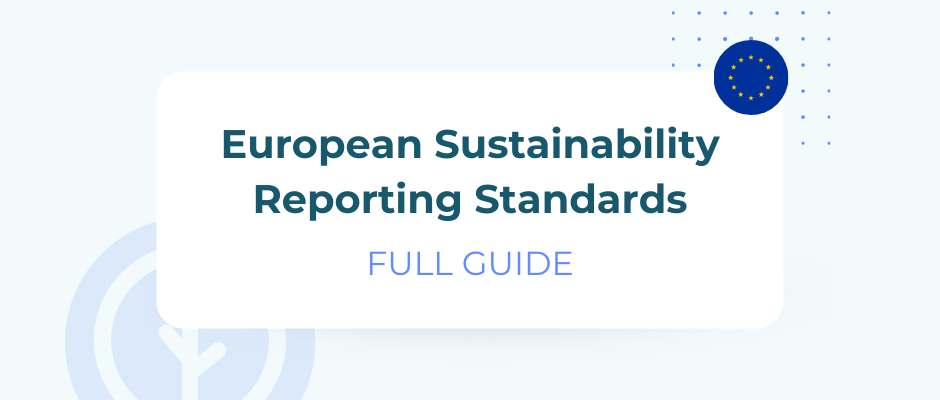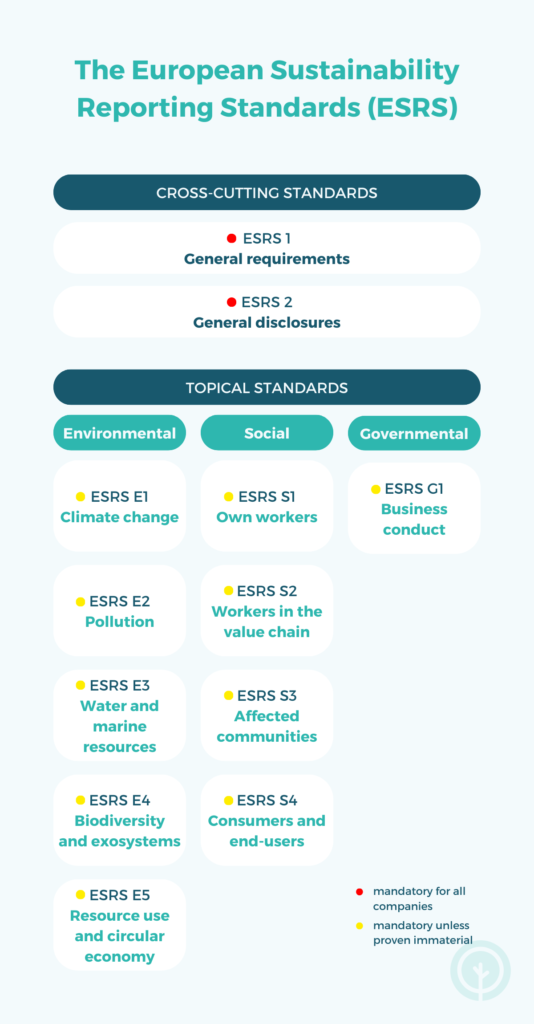ESRS and CSRD – What should my company report about?
Guide to the European Sustainability Reporting Standards (ESRS) of the CSRD
Reading time: 4-5 minutes
Reading time: 4-5 minutes

As of 2025, the first companies will have to start reporting under the Corporate Sustainability Reporting Directive (CSRD). This directive makes reporting mandatory for over 50,000 companies operating in the EU, with the goal, among others, to standardise reporting standards so that stakeholders can better compare different companies.
To reach this goal, the European Financial Reporting Advisory Group (EFRAG) has published a new set of sustainability reporting standards called the European Sustainability Reporting Standards (ESRS). The European Commission has approved the ESRS on July 31, 2023.
The following article will present the new ESRS and how they will affect companies reporting under the CSRD.
After four weeks of public consultations, the first European Commission has approved the ESRS.
The ESRS are a set of standards that companies reporting under the CSRD will have to follow. In particular, the ESRS defines the set of requirements, topics, and reporting standards that companies must adopt to be CSRD-compliant. The standards cover environmental, social, and governance matters.
So far, there are 12 sustainability reporting standards representing all the company’s responsibilities regarding sustainable development.
The ESRS are divided into two main categories: cross-cutting standards and topical standards. The former don’t concern a specific topic and must be applied to all companies reporting under the CSRD. The latter relate to a specific topic, namely environmental, social, and governmental standards, and are sector-agnostic, meaning they could potentially concern every company, whatever field it operates in. Companies will have to carry out a materiality assessment to understand if the topical standards have to be applied.
In the following table, you will find a summary of the 12 standards.

European Sustainability Reporting Standards (ESRS). Tapio, 2023
The ESRS 1 “General requirements” presents all mandatory concepts and principles that need to be applied by companies to comply with the CSRD. The main principle is to disclose all material information about sustainability impacts, risks, and opportunities.
The ESRS 2 “General disclosures” includes all essential and mandatory information that needs to be disclosed by all companies. This includes, for example, information on governance, strategy, management of impacts, risks and opportunities, and metrics and targets related to climate change.
As you can see in the table above, environmental, social, and governance topical standards are not mandatory when the data points are not included in ESRS 1 and 2. However, if the company decides not to report about them, it will have to provide an in-depth material assessment to explain why it is not concerned by these standards.
The ESRS and CSRD take a “double materiality” perspective. This means that companies are required to report on their impact on people and the environment and vice versa.
As mentioned above, some data points of topical standards may be omitted if the company provides an in-depth materiality assessment that proves that those standards don’t concern its activity. The possibility of omitting topical standards, including climate change, has been heavily criticized by some who would have wanted at least the ESRS E1 “Climate change” mandatory for all.
The European Commission has responded to this critique by stating that, with climate change being all-encompassing, it is difficult to imagine that a company could prove that climate change is not material. So, it only remains for us to see how, when, and whether the authorities will check the reports compiled under the CSRD.
To facilitate the transition towards ESRS- and CSRD-compliant reports, all undertakings may omit information related to:
Companies with less than 750 employees may omit the following information:
The ESRS and CSRD, being new tools, will undergo some updates in the future.
By request of the European Commission, the EFRAG will periodically publish additional non-binding technical guidance on the application of the ESRS. This will help companies align themselves with the new sustainability reporting standards.
In the following months, the ESFRAG will also publish sector-specific standards and standards for small and medium companies.
Finally, it is essential to remember that the ESRS are not in force until the delegated regulation passes the two-month scrutiny period, which can be extended for an additional two months if needed by the European Parliament and Council and until published in the Official Journal.
Discover where your company is standing with its climate strategy and the CSRD compliance in just 5 minutes.